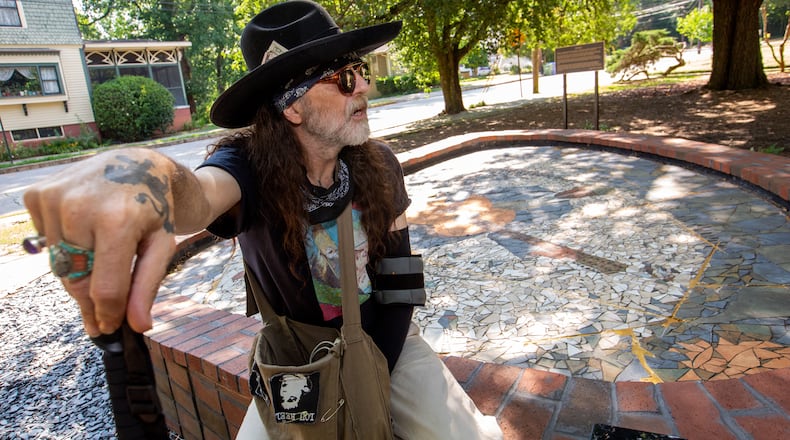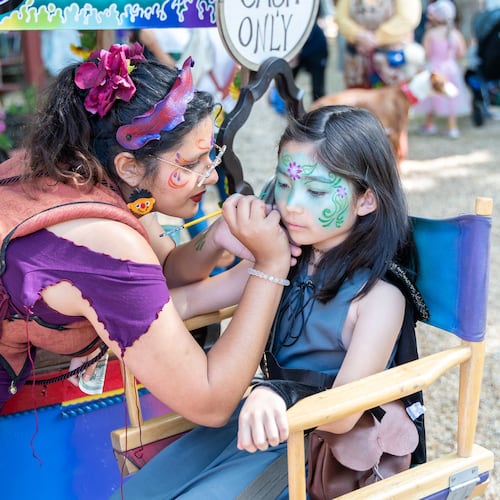At the corner of Euclid and Austin avenues is a three-ton portrait of Georgia blues legend Blind Willie McTell.
Composed of fractured pieces of stone and tile, the enormous mosaic depicts the notable street performer in jacket and tie, his fingers wrapped around his 12-string guitar, a sun to his left and a moon to his right, birds skirling in the air.
It is the second incarnation of the mosaic, which measures about 18 feet across. Embedded in thick concrete, it originally served as the centerpiece of Findley Plaza, the public gathering spot in the crossroads that gave Little Five Points its name.
In 2019, in the face of planned redevelopment that would have destroyed the artwork, private donors instead paid the creator, Jason Evers Johnson, to have it unearthed and moved. This necessitated breaking the heavy concrete into pieces, lifting it by crane and storing it temporarily on the grounds of the Little Five Points Community Center, three blocks southwest of the plaza.
Credit: Jenni Girtman
Credit: Jenni Girtman
Last summer Johnson reassembled the mosaic. The result should have been a win-win. Instead, the broken image now represents broken relations between the artist and his benefactors.
At issue are changes the community center made to the mosaic after it was installed. “Blind Willie could look at it, himself, and see that it had been damaged,” said Johnson, 55, during a recent visit to Atlanta.
“We are sorry — the board of directors and everybody within the Little Five Points Community Center — he feels that way,” said David Shorter, the executive director of the center, but Shorter is surprised at the reaction. “It is still the Blind Willie McTell mosaic, as it was in the plaza.”
Credit: Brad Boothe
Credit: Brad Boothe
This story began in 2005, when Johnson was commissioned by the City of Atlanta to create the mosaic. A longtime resident of the Little Five Points area, he had worked with the city on many occasions, painting murals and leading public art workshops for kids. After creating the mosaic, using stone and tile he had salvaged from many other projects, he moved to the Perugia region of Italy to be with his newborn son, Cosimo.
When the portrait of Blind Willie was threatened, Don Bender, a Little Five Points booster, political activist and property owner, persuaded Johnson to return to Atlanta to relocate the mosaic.
Bender guaranteed Johnson a $20,000 budget to move the artwork, and assembled a committee to help coordinate the project and to raise money. He personally committed to paying any costs not covered by donations.
To move the mural in one piece would have cost more than $100,000, Johnson said, so he decided to break it into pieces, and reassemble it according to the Japanese art of kintsugi. That art uses powdered gold to emphasize the seams in the repairs of broken pottery.
To make the move, the Blind Willie mosaic was sliced into more than a dozen chunks, the largest of which weighed 850 pounds. Johnson planned to use a gold-colored resin between those pieces as a way of referencing the kintsugi aesthetic, but on a larger scale.
During the reassembly last summer the weather was bad. Johnson, his son and an outside contractor put up a canopy to keep the rain off the project, but some of the resin spilled out of the joints between the sections.
Shorter said some members of the community center told him the project looked sloppy. Johnson was, by then, back in Italy, and Bender communicated with him about cleaning up the spills. Johnson has suffered several strokes, and Bender said “There was a question about whether his health would permit him to come back.”
By that time the ownership of the piece had been transferred to the community center, and the center’s board voted, against Bender’s wishes, to hire a conservator to remove some of the spills.
In June Johnson was invited back to U.S. to a dedication of the mosaic, which had been dressed up with cast-metal signage, a gravel walkway and plantings.
He arrived on June 27 and visited the mosaic on June 28. “I literally had that feeling where your stomach drops,” he said. “I thought it had been vandalized and they hadn’t noticed it yet.”
While spills were cleaned up, the gold resin had also been removed from a few seams, including one that ran down the middle of the image, through the face of the guitarist.
Johnson’s emails to members of the center and to Bender were blistering. “I was pissed off,” he said.
On Friday, July 8, Johnson sat on the brick wall that surrounds the mosaic, his long hair held back with a bandana and a Billy Jack hat. He carried a cane to deal with the lingering effects of his last stroke.
“It was altered, against my wishes, in an obvious way,” he said. “My shock is that there’s any doubt about this.”
He said the center owes him something between $30,000 to $80,000, for his effort, and for the embarrassment he has dealt with. “I feel like I need to get reimbursed for getting ambushed the way I was,” he said.
But he may have a hard time collecting.
“He has been so hostile to so many people, and very offensive,” said Bender. “It’s difficult to swallow the feeling that we have been treated very disrespectfully and come back and say ‘hey let’s give you some more money.’”
Bender has already committed $25,000 of his own money to the project, including $10,000 for part of the cost of moving the mosaic, and another $10,000 bequest at his death to cover maintenance.
Christina Hodgen, a member of the committee that coordinated the project, said “I think there’s a sane solution that doesn’t involve $30,000. It would be sad to me if the negativity surrounding this is all that’s remembered.”
The center, the committee and Johnson are still working to find a middle ground, and this blues song is not over yet.
About the Author
The Latest
Featured




